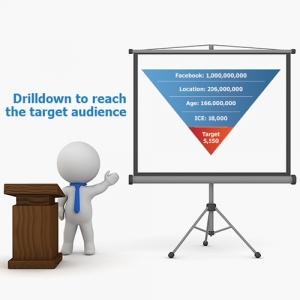 Facebook can be difficult to navigate when initially creating a company “page”. With over 1 billion Facebook users worldwide, finding followers interested in your business should be easy, right? Wrong. While you can easily request for your friends to follow your page, it is much more difficult to find new, eager patients willing to follow your business.
Facebook can be difficult to navigate when initially creating a company “page”. With over 1 billion Facebook users worldwide, finding followers interested in your business should be easy, right? Wrong. While you can easily request for your friends to follow your page, it is much more difficult to find new, eager patients willing to follow your business.
The question becomes: how do you acquire new patients, quickly and efficiently, without wasting hours on Facebook searching for leads? Luckily, Facebook makes it easy! Creating an ad allows you to pinpoint the exact demographic you are looking to target and makes them notice your page.
To demonstrate exactly how a Facebook ad can help expand your business page we created our own, here’s how it went.
The Business
The business, in this case, is Norwood Device & Diagnostics. You may remember them from such OPT Magazine issues as “Autumn”, with their Adapt Head & Chin rest. Basically, they are an equipment supplier (chairs, stands, slit lamps, etc.), with a slightly different target audience (you) than that of a typical optical shop (consumers). This should, however, still give you some insights on how, exactly advertising on Facebook works, and how you can segment it to fit your specific goals.
With less than 20 followers to start with, we had a lot of growth potential. We developed small achievable goals with a small budget and got to work creating our ad.
 The Goals:
The Goals:
- Gain 100 followers
- Get 100 website clicks
- Spend 100 dollars
- DOUBLE the page’s engagement rate
The Set Up
STEP 1: Choosing your objective
Facebook offers a variety of options for what type of ad you can run from “increasing post reach” to “raise attendance at your event”, each serving a specific purpose which helps identify your marketing objectives. For the purpose of Norwood’s ad, we decided to choose “Send people to your website”. We chose this for two reasons: first, having a new Facebook page, with a smaller breadth of product information, it was important that we steer consumers to company’s website. Second, this still allows the opportunity for new followers to like your page, helping to build Norwood’s social media presence.
However, each ad and business has different objectives, so choose what fits your business best.
STEP 2: Choosing your audience
As mentioned before, Facebook has over 1 billion users. In order to narrow that down to better suit your needs, Facebook offers you the ability to customize your audience. You can narrow down your search from all Facebook users to customers in a specific location, in a specific age group, and with specific interests, careers, or education.
Unlike many eye care professionals, Norwood’s ad was not targeting a specific location, but rather the entirety of the United States. This helped lower our potential audience down to 206 million users. However, this audience was still much too broad, so we set our age range to users who were between 25 and 65+ years old including both males and females, narrowing our audience further to 166 million. The most important tool in narrowing our search was choosing the right interest, career, or education of our ideal consumer.
Being that Norwood sells equipment for ophthalmologists, optometrists, and opticians, those were the interests we chose to highlight, including anyone with a job title or education listed as something in the optical industry. This narrowed my audience down to 18,000 potential customers. While reaching a very broad audience may put your ad in front of more people, it will be much less likely that your ad will be presented to viable customers, in turn wasting your advertising budget.
A similar strategy can be used for an optical practice. For example, if you want to advertise a sale on sunglasses at your office, chose for your ad to reach potential customers in your surrounding area, who are within an age group of your choosing, that list their interests as “eyewear” and/or “sunglasses”. These consumers are likely within driving distance of your office and have an expressed interest in eyewear. You can also focus on people with specific interests in say, motorcycles, which may be a good target for the new wrap frame line you just got in.
 STEP 3: Choosing a budget & Schedule
STEP 3: Choosing a budget & Schedule
Now, you didn’t think this was all free, did you? The point of this article is to prove that you do not have to spend a fortune to have a successful advertising campaign. For our ad we spent $100 in total over four days. We chose to run the ad from Friday to Monday, based on analytics from our various Facebook pages showing that these are our high traffic days, but every business will be different, so adjust your campaigns accordingly.
For the sake of our ad, we decided four days was the appropriate amount of time to reach our target audience, however, some practices may find it beneficial to have a smaller daily budget over a longer period of time. These types of decisions depend largely on your objective. Are you trying to promote a sale or an event? Then a short term campaign is for you. Are you hoping to gain patients for your new practice? Then consider running a long term campaign that reaches more customers over a longer period of time.
After we chose our demographics and budget the potential reach for our ad was slightly under 5,500 Facebook users.
STEP 4: Create graphic and copy
The final piece to the puzzle, when creating your Facebook Ad, is adding the visuals. We suggest hiring a graphic designer to make the ad look professional and help guarantee you fulfill all of Facebook’s specifications. The rules are as follows: the image you chose, if it contains any lettering may not have more than a 1.91:1 ratio of image to text, this often eliminates the ability to use your practice’s name or logo as the main image, a graphic designer can help you get creative with this ratio. Additionally, in order to optimize your ad they advise you use less than 90 characters of texts in your description and less than 25 characters as a headline. While Facebook will not stop you from breaking any of these rules, not adhering to them can affect the performance of your ad. This step could be tricky – don’t be afraid to ask for help!
Now that you’ve set up your ad, it’s time to “place order” or, in other words, start running your Facebook ad. Once the ad is running, your work is done and it’s time to sit back, relax, and eagerly wait for your results.
The Results
After four days, with a $100 budget our results were in!
The first metric we looked at was “people reached”. This means how many people saw the ad during our selected time frame. Out of a possible 5,500 users we were able to reach 3,500. We were pleased with this result, but it also leaves us room for improvement. In the future, we may use a different graphic or extend the timeframe of the ad to aid in expanding our reach.

Next, we looked to our “clicks to website”. This is the number of people that responded to our call to action by clicking on Norwood’s link to their website. We were able to acquire 149 unique clicks to their page, that’s 149 potential new customers who are interested in their products.
Finally, we looked at the number of new followers gained during this time frame, and we were able to hit our mark of 100 followers. While this number is not groundbreaking, it is growing everyday! It is more important to us to grow a community of engaged customers, than it is to have a large number of uninterested followers.
 Pro-Tip
Pro-Tip
When running an ad to entice new and potential patients/customers to like your page, also do something on your page to get them excited to be a part of your community! For example, while we ran Norwood’s ad they simultaneously promoted a product giveaway on their page.
Long Term Effects
Since the Facebook ad ended, Norwood has seen a 14% increase in overall post reach and an 800% increase in post engagement. These factors will greatly help in the success of future Facebook ads, and in organically spreading brand awareness.
While Social Media marketing may seem daunting to those with little experience, it is a very powerful and affordable tool to help expand your practice, and more importantly allows you to interact and build relationships with existing patients.
– Maria Magnotta
